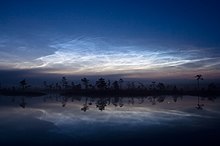Noctilucent cloud
| Noctilucent cloud | |
|---|---|

|
|
| Abbreviation | NLC/PMC |
| Altitude | 76,000 to 85,000 m (250,000 to 280,000 ft) |
| Classification | Other |
| Precipitation cloud? | No |
Night clouds or noctilucent clouds are tenuous cloud-like phenomena in the upper atmosphere. They are visible in a deep twilight. They are made of ice crystals. Noctilucent roughly means night shining in Latin. They are most commonly observed in the summer months at latitudes between 50° and 70° north and south of the equator. These clouds can be observed only during local summer months and when the Sun is below the horizon for the observer, but while the clouds are still in sunlight.
They are the highest clouds in Earth's atmosphere, located in the mesosphere at altitudes of around 76 to 85 kilometres (47 to 53 mi). They are too faint to be seen during daylight, and are visible only when illuminated by sunlight from below the horizon while the lower layers of the atmosphere are in the Earth's shadow. Noctilucent clouds are not fully understood and are a recently discovered meteorological phenomenon; there is no confirmed record of their observation before 1885, although they may have been observed a few decades earlier by Thomas Romney Robinson in Armagh. Doubts now surround Robinson's out-of-season records, following observations, from several points around high northern latitudes, of NLC-like phenomena following the Chelyabinsk bolide entry in February 2013 (outside the NLC season) that were in fact stratospheric dust reflections visible after sunset.
Noctilucent clouds can form only under very restricted conditions during local summer; their occurrence can be used as a sensitive guide to changes in the upper atmosphere. They are a relatively recent classification. The occurrence of noctilucent clouds appears to be increasing in frequency, brightness and extent.
Night clouds or noctilucent clouds are composed of tiny crystals of water ice up to 100 nm in diameter and exist at a height of about 76 to 85 km (47 to 53 mi), higher than any other clouds in Earth's atmosphere. Clouds in the Earth's lower atmosphere form when water collects on particles, but mesospheric clouds may form directly from water vapour in addition to forming on dust particles.
...
Wikipedia
